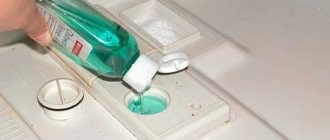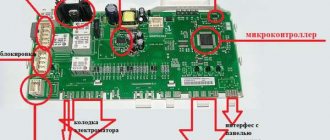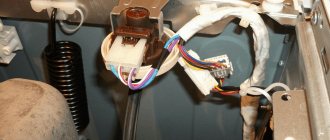Main device of the dishwasher
If you want to know how an Indesit, Bosch, Electrolux or dishwasher from any other brand works, be sure to read the material to the end. Let's start with the most important thing - the heart of the device. It is a powerful motor, sometimes called a circulation pump.
. It circulates water with detergent or rinse aid, taking it from the working chamber and returning it through the rocker arms. As for the rocker arms, they serve as rotating spray nozzles.
The largest element in a dishwasher is the working chamber. It is in it that the rocker arms are located, playing the role of washing elements. There are also baskets where dishes are placed. Baskets can be adjusted in height, and some manufacturers provide them with a transformable design, which makes it easier to store kitchen utensils of non-standard sizes.
- Filter – provides filtration and removal of solid contaminants (food residues);
- Drain pump (also known as drain pump) – removes dirty water outside the dishwasher;
- Drain hose - its purpose is clear without any comment;
- Aquastop - it is not present in all dishwashers, but it allows you to protect against leaks. The executive element of this unit is a solenoid valve located at the very end of the inlet hose.
Also in the device of any dishwasher there is the following combination:
- Inlet hose - it is connected to the water supply system, through which cold water flows into the device (or hot water, if someone connected the equipment to a hot water supply pipe);
- Solenoid valve - participates in filling water, shutting off or opening its supply;
- Water heater - classic or instantaneous. The latter helps reduce cycle times by heating water instantly rather than gradually.
Please note that in front of the inlet hose there is a simple coarse filter in the form of a metal mesh
. It plays an important role in the design of a household dishwasher, filtering out large contaminants that can enter the dishwasher from the water pipe.
As we can see, the design of dishwashers is extremely complicated. And all this despite the fact that we have not yet touched on a number of important organs, nodes and systems. Ion exchanger is a very important part responsible for water softening
. The thing is that salts dissolved in hard water interfere with normal washing. The exchanger, which operates on the basis of a special ion exchange resin, allows you to replace magnesium and calcium ions with sodium ions, resulting in softer water.
A container is installed in conjunction with the ion exchanger, into which salt or substances replacing salt are poured - they help restore the amount of sodium ions in the ion exchange resin. Salt is taken from here automatically, its amount depends on the settings in the dishwasher. The container holds approximately 1 kg of special salt for dishwashers.
In addition to all this, dishwashers contain pressure switches (water level sensors), thermostats (determine the temperature of the washing mixture), and various touch sensors (in machines with automatic programs). Water inlets for collecting water are also installed here, and there are numerous connecting hoses and clamps. The whole thing is wrapped in a body with effective noise insulation.
We forgot to mention the most important detail in the internal structure of any dishwasher - this is the control board, which is the “brain” for all the filling.
. It is from this that the wires go to the sensors and various electrical modules. A control module works in conjunction with the board, on which knobs, buttons, indicators and other elements are located.
Older dishwashers had mechanical control modules. They are not used in modern technology - their device is based on electronics.
Overview of the most common faults
In general, dishwashers from the Swedish brand are deservedly considered to be of high quality. Typically, Polish-assembled products are cheaper and break down more often. However, it is noted that Electrolux machines are distinguished by a durable body and a reliable circulation pump. Parts such as filters, gaskets, wiring terminals and other little things are traditionally made at a high level and rarely cause trouble.
Typical breakdowns of this equipment usually include the following malfunctions:
Very often, the causes of such malfunctions are violations of recommendations for using the device. If problems begin soon after the start of operation or occur too often, you need to check for such violations.
In addition, it doesn’t hurt to make sure that the dishwasher is installed correctly and connected to the sewer and water supply without any problems. The intricacies of installing and connecting a dishwasher are discussed in our other article.
Reason #1 - clogged drain/water supply
Poor quality of tap water is a common problem in many regions. Increased hardness, the presence of mineral inclusions and contaminants have a sad effect on the condition of household appliances, and dishwashers are no exception. For this reason, a filter must be installed before water enters the device.
It needs to be regularly washed, cleaned, and replaced in a timely manner. If damage has developed in it over time, you should not ignore it; you must immediately install a new filter. Otherwise, all contaminants will enter the dishwasher mechanism. Do not think that cleaning with chemicals will eliminate this effect. A reliable filter is essential.
The drain filter in this technique must be constantly cleaned; it can easily become clogged with food debris and other contaminants.
To clean it, you need to follow these simple steps:
If there is too much dirt, use a brush to clean it. Some owners believe that they can get by with just one drain filter, but practice shows that an additional filter in front of the supply hose will never be superfluous.
In addition, you should periodically carry out preventative cleaning of the dishwasher drain. To do this, you also need to use high quality products recommended by the manufacturer. Cleaning is done only with this product; there is no need to add other chemicals, rinse aid or salt to the dishwasher, and, of course, there should be no dishes there.
We recommend that you familiarize yourself with the features of cleaning a dishwasher at home.
Replacing the heating element of a dishwasher is a relatively simple operation if the technician has at his disposal a new, working element with the appropriate characteristics
To prevent breakdowns, you must strictly follow the operating instructions.
Here are the basic recommendations for using Electrolux dishwashers:
More detailed recommendations for using dishwashers are given in the following material.
Reason #2 - problems with the water heating device
If there are problems with heating the water during the cycle, most likely a malfunction of the heating element, sensors, or incorrect operation of the control unit is to blame. The weak point of many Western models of household appliances is their high sensitivity to sudden changes in network voltage. Such surges can damage the control board triac; this element will have to be replaced.
To correct the situation, you need to disconnect the dishwasher from the power supply, water supply and sewerage. The built-in machine will have to be completely dismantled. After this, using a tester, you need to check the serviceability of the heating element, as well as all electrical circuits. If you are unable to determine the fault yourself, you will have to contact a service center that has the appropriate diagnostic equipment.
To reflash or replace the dishwasher control board, you need to contact a service center; doing it on your own in this case can cause a lot of harm.
It is not difficult to prevent such a sad situation; just install a voltage stabilizer. The cost of additional equipment will pay off, because replacing the control board will cost much more.
Reason #3 - problems with the command apparatus
With regard to the electronics of the dishwasher, unprofessional intervention can lead to the fact that the situation will only worsen, and you will have to buy a new dishwasher.
A failure of the control module can also result in periodic freezing of the machine during the washing cycle. To correct the situation, you just need to turn off and then turn on the device again. If such a malfunction occurs rarely, there is no need to worry. But when the car has to be restarted over and over again, this most likely indicates a manufacturing defect.
To drain the water that has accumulated inside the dishwasher chamber, you will have to turn it over. After this, you need to restore the normal position of the sensors
Such a malfunction will have to be repaired by a service center after detailed diagnostics. This is the most expensive type of repair; in some cases, its cost can be comparable to the price of a budget dishwasher. But it also happens that diagnostics reveals a malfunction of a sensor; replacing it will cost much less.
You shouldn’t put off calling a technician “for later” if the car constantly freezes, so as not to worsen the situation. If the owner has experience in repairing home appliances, replacing a sensor or heating element will not cause big problems. Another problem typical of Electrolux dishwashers is deterioration in the quality of washing.
If the water stops heating or is heating too slowly, you need to check the condition of the heating element; most likely, it needs cleaning or replacement
This can occur either due to the fact that the water supply to the chamber is not fully supplied, or as a result of improper supply of detergents. You need to carefully inspect the camera after each wash. If the tablet has not completely dissolved, there is detergent or rinse aid left in the container, all these are signs of problems.
First you need to check whether there is water in the water supply system and whether it has sufficient pressure. Then you should check the condition of the filters and supply hose. If dirt has accumulated there, it will cause poor water flow and problems with washing quality. It is enough to wash it all out for the situation to return to normal. The filters may need to be replaced.
To get to the control board, you need to remove the top cover of the control unit, unclip the latches and disconnect the chips that connect the unit to the machine
Another source of trouble is a malfunctioning valve in detergent containers. Finally, you need to ensure that supplies are loaded and used in accordance with the manufacturer's recommendations. Limescale deposits accumulated inside the sink and on the surface of the heating element can cause many of the listed breakdowns.
Regular maintenance of the device will avoid costly repairs. The following recipe may be useful: add 250 ml of table vinegar to the detergent container, start the Economy mode, stop the procedure in the middle of the cycle for one hour, then continue washing. This cleaning should be done two to three times a month. We recommend that you familiarize yourself with the five best dishwasher cleaners.
What to do if the dishwasher is still under warranty
For at least the first year after purchase, do not repair it yourself - by doing so, you will deprive yourself of warranty benefits. The warranty period and conditions must be clarified when purchasing household appliances.
If you use detergents that are not intended for dishwashers to wash dishes, warranty repairs may be denied.
During this period, you can work to remove blockages in the dishwasher filters. In addition, it is allowed to clean the holes in the sprinkler rocker arms from dirt and food debris if the PMM begins to wash dishes poorly.
Do not forget that many defects in work occur due to non-compliance with operating rules. The machine may not work only because there is no water in the water supply or someone has closed the inlet ball valve.
Modern authorized service centers have all the necessary tools and spare parts for warranty repairs
Therefore, you need to periodically check: the presence of electricity in the sockets, the water pressure in the water supply and the absence of blockages in the sewer. If you connect the dishwasher to the communications yourself, make sure you did everything correctly. An error may result in the PMM refusing to wash dishes.
Do not take warranty equipment for repair yourself; the store should arrange delivery
Remember: you do not need to take the PMM yourself for repairs to a service center under warranty. This must be done by the store that sold you this equipment, because it weighs more than 5 kg. It is quite possible that technicians will volunteer to repair the device at home.
Typical failures
According to statistics, 90% of cars under the Electrolux brand that are sold in Russia are manufactured in factories in Poland. Their quality is slightly worse than their counterparts from Germany, but the pricing policy is not bad either. Experts from service centers, especially for Russian consumers, note the following advantages:
No particularly obvious shortcomings or weaknesses were found, but, like other brands, there are some typical breakdowns and malfunctions from which no one is immune:
In order not to frequently repair your dishwasher, you must always pay attention to the condition of the equipment and adhere to the recommendations set out in the instructions.
If the capacitor is faulty
Voltage fluctuations in electricity and other negative factors can cause the fuse of an Electrolux machine or any other to break. Therefore, if the dishwasher does not turn on, and the socket, cord and water supply hose have been checked for serviceability, then it is necessary to check the condenser. If the fuse is blown, this is another reason why the dishwasher won't turn on.
To diagnose this important spare part, the machine will have to be disassembled, since the fuses are located under the pan. It is recommended to prepare a rag in advance, as stagnant water may spill out of the equipment. You will also need a multimeter to measure resistance.
If no resistance is detected, then the capacitor has failed. You need to remove it and buy a similar one. According to the diagram, we put the new fuse in place. If even after these manipulations the dishwasher does not turn on, you should contact a technician for help.
Removing internal and external blockages
A clog may be the reason why your dishwasher does not turn on when you press the start button. A similar problem can be solved without the involvement of a repairman. There are such blockages inside and outside.
Possible equipment diseases
Some users who have absolutely no understanding of the complexities of household appliances call service centers for every little thing. But many problems can be solved on your own:
- water does not enter the unit;
- water does not drain;
- The product freezes when turned on.
In the above cases, you can try to revive the equipment yourself. First, check whether the water supply tap is open, then check whether the door is closed tightly, inspect the outlet, maybe the reason is its malfunction. Water may not drain due to clogged filters or connection pipes in the drainage system. If everything is in order there, you need a wizard to diagnose all nodes.
Disassembling the dishwasher
It would be nice to understand how this technique washes dishes.
- Operating principle and device:
When the washing program is activated, the aquastop valve opens.
The stream of water begins to rotate the flow sensor, which registers the volume of incoming water.
Consists of a housing, a fan impeller with a permanent magnet and a printed circuit board with a reed switch. Water sets the fan impeller in motion. A magnet attached to the fan impeller drives the reed switch 2 times to the (North/South/North) position. The generated pulses are counted by the electronics of the control module.
Water entering the machine through a special tube squeezes out air in the pressure valve (pressure gauge).
Two microphones - one aquastop, the second water level sensor. Water is collected, the second sensor is triggered, the water continues to accumulate, the red float 3 raises, it turns on microphone 1.
The pump circulates the water in a circle, and the heater warms it up. A compartment with a tablet opens. The dishes are washed. The temperature sensor checks the water temperature - in accordance with the selected program.
1 – water softening system. 2 – foam float of the aquastop system 3 – drain (sewer) pump 4 – circulation pump 5 – “brains”, also known as the control board in the casing 6 – water supply valve to the machine.
- Protection device (emergency sensor):
At the end of washing, the drain valve opens and the water is drained using the drain pump. A new one is poured, warmed up and washed. Merges - similar to the first stage.
In the event of a leak, the machine is designed so that water always flows into the pan. There is a leakage sensor there - a foam float with contacts. If it floats up, the machine goes into emergency mode. Opens the drain valve and turns on the drain pump.
This is a hardware program - we stand and hum until it dries up. It may hum for two days, or until the pump dies from overheating.
- Disassembling the dishwasher:
The article describes an approximate lg diagram for informational purposes. The principle of operation is similar in Indesit Bosch Electrolux and Ariston. Be careful not to get water on the electronic components.
Before you start:
1.Unplug the cord from the electrical outlet to avoid electric shock. 2.Close the water tap. 3.Remove all dishes. 4.Remove the bottom shelf and top shelf. 5.Disconnect the fill hose and drain hose. 6.You will need a rag to collect any remaining water.
1.To remove the bottom cover, it is usually enough to unscrew two screws.
2. Front panel - unscrew several screws from the back of the door.
3.4.Control panel assembly:
– Remove the screws. – Remove the connecting wires. – Remember or take a photo of the order in which the connectors are connected so that you do not mix up the connectors during assembly. – Remove the lock assembly, display – Unscrew the 8 screws securing the control module.
5.Ventilation and drying system assembly
- Open the door. – Unscrew the door from the bracket. – Disconnect the connectors and wires. – Remove the air duct. – Turn the inner cover counterclockwise. – Remove the detergent dispenser.
6. Door springs (right and left)
– Pull the spring up and remove it from the bracket loop. Be careful not to injure yourself on the sharp edges of the tank! – Remove the spring from the loop. – Lift the door and remove it from its hinges.
7.8. Turn over and remove the bottom housing cover.
9.10. Unscrew the screws and remove the base and water intake valve.
11,12.Remove the tray holder and push the tray down, pressing the hooks to the side. Be careful not to drop the tray assembly. – Loosen the nut of the heating element and pull it out of the pan. – Unscrew the fixing screws and remove the drain pump.
- Disassembling a BOSCH dishwasher:
- Basic Troubleshooting
Troubleshooting tips
For any type of breakdown, it is important to carry out the most accurate diagnosis. Often, the participation of a master is not necessary. Using the dishwasher operating instructions, you can carry out this procedure yourself. For example, if the equipment cannot be turned on, the Bosch dishwasher repair instructions suggest first checking the voltage level in the network.
A guide to troubleshooting other device malfunctions from the manufacturer Bosch suggests:
- visual inspection of the device;
- identifying the presence of deformation of the power cord;
- checking the correct connection of the water drain and its supply hose.
Sometimes repairing a Bosch dishwasher at home on your own is impossible without partially disassembling the equipment. For example, the SRV55TO3EU model requires mandatory testing of the functioning of internal components, including valve sensors and pumps.
Disassembling Bosch dishwashers
Some dishwasher maintenance tips: Cleaning the insides
You don't need to clean the insides of your dishwasher if you use it regularly.
But if you use it once a week or less, dirt and odors may appear. In this case, you need to wash the drain filter and the insides of the machine with a specialized detergent. And put it in an intensive wash without dishes. External cleaning.
Simply wipe down the outside of the dishwasher with a damp sponge and add a little dish soap.
Cleaning the Filter
Many dishwashers have a filter at the bottom, or under the lower spray arm, that needs to be cleaned regularly.
If you have this type of filter, read your owner's manual to learn how to remove and clean it. If it is damaged, replace it to protect the pump and motor seals from particles that may be in the dishwasher. Cleaning the Spray Arm
Over time, the small holes in your dishwasher's spray arms can become clogged with pieces of paper, toothpicks, glass, etc. Your dishwasher will clean dishes better if you clean out these small holes from time to time. Learn more about how a dishwasher works! If you need more help on dishwasher repair, or any other advice on home appliance repair, you can always ask for help on the forum.
We want this repair to be completed safely. This video will show you one or more of these icons to alert you when to be extra careful. Some repairs will require you to take your dishwasher apart. Before starting work, turn off the power to your dishwasher and turn off the water supply valve. To access the water fill valve or terminal box, remove the screws holding the bottom panel in place and move it to the side. If you need to access components located in the door panel or control module, open the door and remove the screws on the inside of the door that secure the outer door panel. Close the door and slide the outer door panel down to remove. You can now remove the control panel mounting screws. And remove the control panel. After completing the repair, install the panel and tighten the screws on the inside of the door to secure it. Reinstall the outer door panel by sliding it into place and tighten the screws to secure it in place. Install the bottom panel and secure it with screws. To access the components located under the tank, you first need to remove the dishwasher. Once the dishwasher is removed from the furniture, remove the hinge caps and set them aside. Then remove the hinge hooks on both sides of the door. As before, remove the outer door panel by removing the screws on the inside that hold it in place. Again, close the door and slide the outer door panel down to remove. Remove the screws to remove the inner plate. Detach the plate from the frame and brackets and set it aside. Slide the soundproofing gasket to the side and remove the screws on the front and back that hold the dishwasher base to the frame. Remove the lower basket, remove the lower spray arm and turn the filter basket counterclockwise to remove it from the pan. Remove the fine filter. Now remove the mounting screws that secure the bottom spray arm bracket to the pan. Unscrew the screws securing the pallet bracket and remove the supports and screws. Be prepared for a small water leak. Remove the insulation and side cover. Now carefully tilt the dishwasher back so that the back of the dishwasher rests on the blanket or carpet. Disconnect the fill hose from the clamps and disconnect the hose from the pan. Now slide the frame away from the tank. Remove the drain pump by pressing the latch and turning it clockwise. If necessary, remove the circulation pump from the pan assembly, disconnect the circulation pump from the frame. Disconnect the drain hose from the pan and remove the assembly from the base. Install the circulation pump into the pan assembly, after connecting the drain hose. Place the assembly on the base and secure it with the mounting clamps. Install the drain pump by lining it up on the pan body and turning it counterclockwise to lock the pump in place. Insert the base so that it aligns with the tank. Connect the fill hose and secure the hose under the clamps. Now carefully lift the dishwasher into an upright position. Reinstall the side covers and insulation. Install the brackets onto the pallet and secure them with screws. Tighten the bottom spray arm bracket screws. Install a fine filter. Place the filter basket in the pan, turning it clockwise to secure it. Install the bottom spray arm and install the dryer basket. Secure the base to the frame by replacing the screws at the front...and back. Install the soundproofing gasket. Install the inner plate, securing it to the frame and brackets. Then secure it with screws. As we said, you can reinstall the outer door panel by sliding it into place. And tighten the screws on the inside of the panel to secure it. Attach the hinge hooks to both sides of the door. Install the caps. Now you are ready to install the dishwasher into the niche. Once the machine is installed, we are ready to supply water to the machine and turn it on. Make sure the dishwasher is working properly. Bosch repair video
DIY dishwasher repair
As you understand, frequent causes of breakdowns are blockages or incorrect connections. Let's look at how to carry out repairs yourself, without the help of a specialist.
Getting ready for disassembly
In a Bosch dishwasher, as in machines of other brands, all the most important parts are located in its lower part. At first glance, it seems that there is nothing difficult in turning the car upside down, removing the pan and gaining access to everything that is required. In fact, in practice everything looks a little more complicated, but more on that later, first, preparation.
In any business, preparation is the basis of all work; approximately half of all failures are the result of a poorly prepared workplace, tools and materials, as well as a lack of necessary information. To avoid getting into trouble, let's start preparing the workplace. Naturally, few people have a full-fledged workshop at home; if you have one, good; if not, it doesn’t matter either. Do the following.
- Slide the Bosch, Siemens (or other brand) dishwasher out of the niche in the kitchen unit, then turn off the water supply and unplug the power cord.
- Disconnect the inlet hose as well as the sewer hose.
- In a convenient place for work, spread cellophane, a few rags on top, and place the dishwasher on them.
Note! Some people find it more convenient to disassemble the Bosch dishwasher in the bathroom so that water leaking from the machine does not flood the floor. If you have a spacious bathroom, you can try this trick.
The “dishwasher” is ready for disassembly. Now let's prepare the tool. Let us note right away that the dishwasher can be disassembled with almost bare hands, the maximum that we need is this:
- Phillips and flat head screwdriver;
- pliers;
- thin awl.
Preparing to use the dishwasher
If you have a built-in dishwasher, disconnect the fastenings, disconnect the communications and remove it to a free place.
Do the same with the freestanding model. But the compact machine, which is located on the table, does not need to be pulled out. It is enough to put it in a comfortable position.
Take care of the tools:
How to remove the lid from a dishwasher?
Installing a dishwasher in your kitchen may not be so easy. Especially if the kitchen was made in advance, and the car was purchased later, and no one checked its exact dimensions upon purchase. So it turns out that the machine does not fit under the countertop, and there are simply no options to place it separately. The question arises: how to remove the top cover of a Bosch machine or any other, what should I do? Let's try to answer it.
Why remove the top cover of the PMM?
When they talk about removing the top cover, we are talking about freestanding dishwashers, because built-in appliances do not have a top cover. You most often have to remove the lid in such dishwashers in cases where the choice of machine was spontaneous. The height of free-standing machines is 85 cm, the standard height of the countertop in the kitchen, taking into account the thickness of the material (3 cm), is also 85 cm, as a result the machine does not fit under the countertop, but it is very necessary.
In this case, the option to remove the top cover from the dishwasher comes to mind. However, not all dishwashers have a removable top lid. There are models in which this cannot be done . Therefore, you need to take the choice of a dishwasher seriously, and find out such points, or even better, if you want to build in appliances, take a built-in dishwasher, specifically designed for this purpose.
For your information! When the countertop is too low, then as an option you can consider a small modernization of the kitchen, for example, increasing the height of the legs of the set or replacing the console with a higher one.
If the lid is removed, this makes the machine lower by 2.5-3 cm, and makes it possible to insert it under the tabletop. However, some experts argue that this is not entirely safe and you need to isolate the “insides” of the machine from possible moisture so that the equipment does not burn out and you do not get an electric shock.
Removing the lid of a Bosch and Whirlpool dishwasher
Removing the lid on a Bosch dishwasher is quite simple. To do this, you need to turn the car with the back wall towards you. At the top on the sides you will see latches that need to be pressed.
If you can’t do this with your hands, then for convenience you can use a screwdriver, but you need to do this carefully so as not to break the plastic elements.
After the latches are released, you need to slide the cover forward from the retaining grooves. If you stand on the side of the Bosch dishwasher door, you need to move it towards you.
The lid of Whirlpool dishwashers is removed in the same way; they also have latches that hold the lid in place.
Removing the lid of the Indesit and Hotpoint Ariston dishwashers
Removing the top cover of freestanding Indesit or Hotpoint Ariston dishwashers is slightly different. You also need to go to the back wall of the dishwasher and at the top of the side end you will see two fastening screws. Unscrew the screws using a screwdriver and pull the cover away from you.
Important! If removing the lid in the dishwasher is provided by the manufacturer, then removing the lid will not affect the warranty period and service in any way, otherwise the warranty will be lost.
In general, many people do not even have a question about removing the top cover in a Bosch dishwasher, since the latches or mounting screws are in a visible place. If they are not there, then most likely such a freestanding dishwasher does not have the ability to remove the lid, so it must be installed under the countertop along with the lid, taking into account the height of the machine. We hope that in our article you found the answer to your question.
How to remove the top cover from a dishwasher
Are you planning to install equipment under the countertop, but the height of the cabinet does not allow it? This happens if the device is built into an unprepared headset. In this case, you can remove the top cover of the dishwasher. How to do it correctly at home, read below.
How to choose the right installation location
If you want to save space and build a dishwashing machine under the countertop, measure the height of the PMM and the distance from the floor to the countertop.
It happens that the height of the dishwasher is equal to the kitchen work surface. Then the only solution is to remove the top part of the dishwasher. Then the case will become 2-3 cm lower, and you will be able to fit it into the intended place.
Unfortunately, not all freestanding models have a removable top. Built-in PMMs do not need this; they are already produced without panels. Therefore, carefully consider the choice of technology.
If you have not yet decided on your choice, it is better to buy a built-in model. You can remove the top of a freestanding dishwasher, but then you will have to insulate the internal parts, which may be damaged by moisture.
Is the countertop too low? Try adjusting or enlarging the legs of the headset.
Is it possible to remove the dishwasher lid?
Is the panel removable in Bosch, Siemens, Whirlpool dishwashers, how to do it? In most cases, the fasteners are located at the rear wall. If you need to repair the model, then you need to disconnect all communications and turn it around.
- Unplug the dishwasher.
- Close the inlet valve.
- Disconnect the inlet hose from the equipment.
- Unclench the clamp and disconnect the drain hose from the siphon (sewer).
Turn the device with the back wall towards you. In Bosch, Siemens, Whirlpool, the panel is secured with latches, which are located in the upper part of the case. Press them with both hands. If you can't press hard, use a screwdriver, just be careful not to damage the plastic parts.
Go around the PMM and stand at the bunker door. Pull the cover towards you and remove.
Indesit and Hotpoint Ariston dishwashers have bolts that need to be unscrewed.
- Go to the back wall of the dishwasher.
- There are two bolts on top.
- Unscrew them with a screwdriver.
- Pull the panel towards you.
The work is finished. All that remains is to install the equipment in the niche under the countertop.
Keep in mind: if the manufacturer allows for removal during installation, then everything is fine. Otherwise it will void the warranty.
How long does the warranty last for a dishwasher, read in the previous publication.
In Veko machines, the disassembly process is similar to the Indesit option. There may also only be two screws here. But there are models where you first need to remove the back part.
- Arm yourself with a Phillips screwdriver.
- Unscrew the five screws around the perimeter.
- Remove the damper.
- Now remove the two bolts from the top.
- Pull the cover towards you.
That's all. The disassembly principle is similar for all brands of PMM. Before starting dismantling, we recommend that you carefully study the operating instructions for the household appliance so as not to void the warranty by mistake.
Cover the exposed area with insulating material to prevent shock and moisture ingress.
If there are no fasteners or bolts at the back wall, then the cover cannot be removed. Therefore, consider installation options before purchasing. Don't have room to place your car separately? Then choose a model that fits into the designated niche.
A visual example will help you dismantle faster:
How to remove the lid from a dishwasher?
Today, a dishwasher is a household appliance that helps to significantly reduce the time spent washing dishes; it is found in almost every home. But there may come times when you need to remove the top cover of the dishwasher, then a lot of questions arise. How to do it? Is this possible in principle? Which models are subject to this procedure and which are not? Read this article and you will find answers to all your questions.
How to remove the lid from a dishwasher?
Is it possible to remove the lid from a dishwasher?
There are various models of dishwashers, and of course, not each of them, due to technical and design features, can boast of a removable lid. In theory, you can find out whether your dishwasher model has the ability to remove the lid, even by brand. This is usually possible in the following brands:
If everything is clear with the stamps, then it may not be entirely clear why and why you need to remove the cover. Therefore, it is worth clarifying this situation.
How to remove the lid from a dishwasher?
Why might you need to remove the cover?
Removing the top cover may be necessary in several common cases, including:
- when integrating the device into a kitchen set;
- when repairing faults.
Let's take a closer look at each of the reasons. In many ways, the first reason can arise from a hasty choice. The incorrectly measured distance from cabinet to cabinet, as well as the height, and the dishwasher no longer fits into the kitchen set.
Of course, this problem can only be solved if you remove the top cover of the dishwasher. But it may not be resolved if the lid is not removed. Therefore, carefully consider the choice and parameters, but this is a completely different story. But it should be noted that if the height of the dishwasher is not suitable, then you can simply adjust the height of the legs of the set.
In the second case, everything is also clear, because when during repairs it is necessary to replace a part, you must first get it out. Of course, at the behest of the pike, it will not be replaced on its own, and in order to get it, you need special skills. First, you need to remove the cover, which is what we are talking about.
How to remove the lid from a Bosch dishwasher?
A Bosch brand dishwasher, as we have already found out, is subject to the process of removing the lid. Therefore, let’s get down to the main thing, analyzing the principle and the dishwasher:
Turn the device with the wall facing you;
Press the latches that are located on the top side. Do this very, very carefully so as not to damage the fragile plastic parts, otherwise finding them will be more than difficult. Please note, this stage is the most difficult.
Use a screwdriver when unscrewing;
Now the opening itself, find the holding grooves and carefully push them forward from them, as in the photo.
How to remove the top cover from a Bosch dishwasher is now clear. It is worth noting that a similar process, from a mechanical point of view, is possible not only in Bosch dishwashers, but also in Whirlpool brands.
Please note that each step, in fact, is not difficult, but requires attention from the performer. Remember that almost every person who has ever used a screwdriver can remove the cover of these brands efficiently. But to be honest, even those who have not used such a tool will also be able to perform these actions.
How to remove the lid from a Siemens dishwasher?
Siemens dishwashers are quite easy to disassemble, but difficult to assemble. If you are not going to repair it yourself without the appropriate education, then this process will not complicate you. A feature of Siemens brand machines is that there are different options for loading laundry, so this factor must be taken into account when removing the lid. If front loading then proceed as follows:
- There are two screws on the back, look at them;
- Unscrew them;
- Please note that it is necessary to preserve the clamps, otherwise the operation of the device will noticeably deteriorate.
- The fasteners are loose, carefully remove the cover.
- Set it aside;
- Start another process for which the lid was removed.
Agree that removing the cover is half the battle. But now you know how to remove the lid from a Siemens dishwasher.
How to remove the lid from a Beko dishwasher?
To remove the top cover of Beko dishwashers, you must adhere to the following rules:
- The cover is attached to the body with two screws; they must be unscrewed. To achieve the desired effect, use a screwdriver.
- Put the screws in a safe place so they don't get lost;
- First, move the cover back;
- Then lift it up.
- The cover is off!
It is worth noting that it is often necessary to remove not only the top cover, because for the Veko brand, depending on the situation, it may be necessary to remove the back cover. Therefore, this case should also be considered:
- There are only five screws between you and the back cover, so take a screwdriver and carefully unscrew them;
- Also remove the screws so they don't get lost over time. Details are important because finding similar ones is harder than you think.
- Move the cover without screws at a right angle in accordance with the body;
- Release the cover from the grooves.
- Pull out the cover.
To summarize, I would like to say that there is no main universal method for removing covers in different models, but there are some general points that are worth discussing again. Firstly, the cover is held in place by two screws. You can usually unscrew them with a screwdriver. Removal occurs either by lifting up or by pulling out of the grooves. The process is not complicated, but may require clarity. For those who want to see once rather than read several times, watch the video.
We hope that our article was useful to you and that you found answers to your main questions. And now you can easily cope with all the tasks you set for yourself. Remember, nothing is impossible. The main thing is to start correctly, and then you will succeed.











